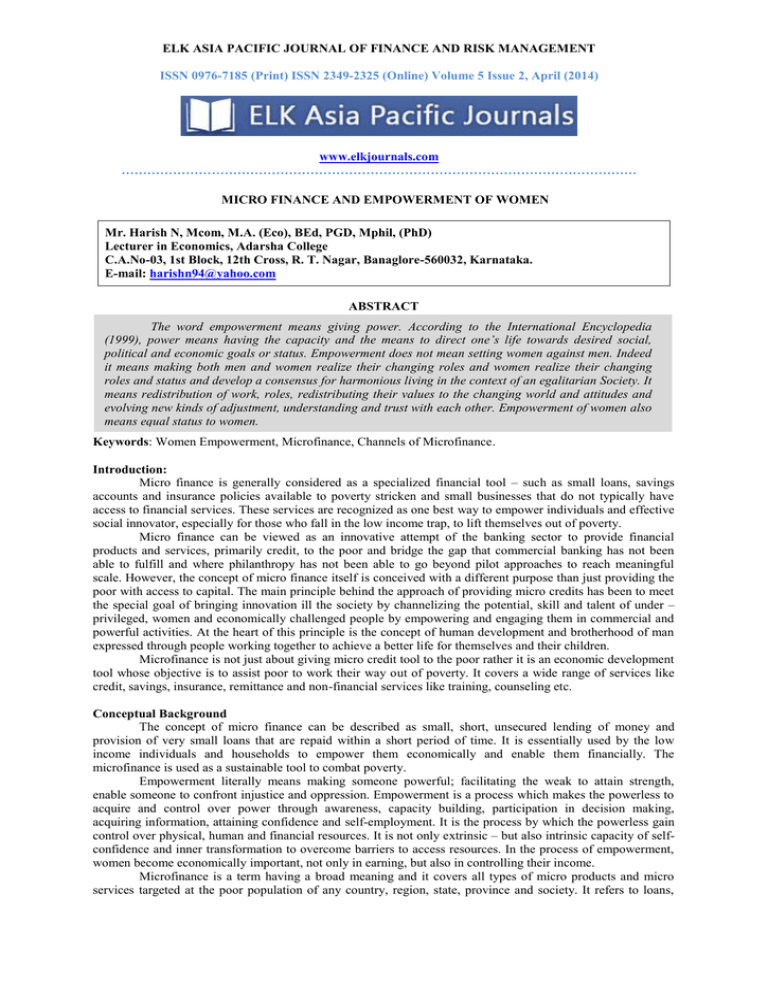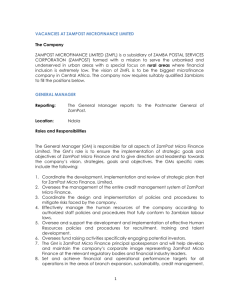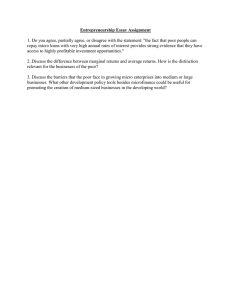micro finance and empowerment of women
advertisement

ELK ASIA PACIFIC JOURNAL OF FINANCE AND RISK MANAGEMENT ISSN 0976-7185 (Print) ISSN 2349-2325 (Online) Volume 5 Issue 2, April (2014) www.elkjournals.com ………………………………………………………………………………………………………… MICRO FINANCE AND EMPOWERMENT OF WOMEN Mr. Harish N, Mcom, M.A. (Eco), BEd, PGD, Mphil, (PhD) Lecturer in Economics, Adarsha College C.A.No-03, 1st Block, 12th Cross, R. T. Nagar, Banaglore-560032, Karnataka. E-mail: harishn94@yahoo.com ABSTRACT The word empowerment means giving power. According to the International Encyclopedia (1999), power means having the capacity and the means to direct one’s life towards desired social, political and economic goals or status. Empowerment does not mean setting women against men. Indeed it means making both men and women realize their changing roles and women realize their changing roles and status and develop a consensus for harmonious living in the context of an egalitarian Society. It means redistribution of work, roles, redistributing their values to the changing world and attitudes and evolving new kinds of adjustment, understanding and trust with each other. Empowerment of women also means equal status to women. Keywords: Women Empowerment, Microfinance, Channels of Microfinance. Introduction: Micro finance is generally considered as a specialized financial tool – such as small loans, savings accounts and insurance policies available to poverty stricken and small businesses that do not typically have access to financial services. These services are recognized as one best way to empower individuals and effective social innovator, especially for those who fall in the low income trap, to lift themselves out of poverty. Micro finance can be viewed as an innovative attempt of the banking sector to provide financial products and services, primarily credit, to the poor and bridge the gap that commercial banking has not been able to fulfill and where philanthropy has not been able to go beyond pilot approaches to reach meaningful scale. However, the concept of micro finance itself is conceived with a different purpose than just providing the poor with access to capital. The main principle behind the approach of providing micro credits has been to meet the special goal of bringing innovation ill the society by channelizing the potential, skill and talent of under – privileged, women and economically challenged people by empowering and engaging them in commercial and powerful activities. At the heart of this principle is the concept of human development and brotherhood of man expressed through people working together to achieve a better life for themselves and their children. Microfinance is not just about giving micro credit tool to the poor rather it is an economic development tool whose objective is to assist poor to work their way out of poverty. It covers a wide range of services like credit, savings, insurance, remittance and non-financial services like training, counseling etc. Conceptual Background The concept of micro finance can be described as small, short, unsecured lending of money and provision of very small loans that are repaid within a short period of time. It is essentially used by the low income individuals and households to empower them economically and enable them financially. The microfinance is used as a sustainable tool to combat poverty. Empowerment literally means making someone powerful; facilitating the weak to attain strength, enable someone to confront injustice and oppression. Empowerment is a process which makes the powerless to acquire and control over power through awareness, capacity building, participation in decision making, acquiring information, attaining confidence and self-employment. It is the process by which the powerless gain control over physical, human and financial resources. It is not only extrinsic – but also intrinsic capacity of selfconfidence and inner transformation to overcome barriers to access resources. In the process of empowerment, women become economically important, not only in earning, but also in controlling their income. Microfinance is a term having a broad meaning and it covers all types of micro products and micro services targeted at the poor population of any country, region, state, province and society. It refers to loans, ELK ASIA PACIFIC JOURNAL OF FINANCE AND RISK MANAGEMENT ISSN 0976-7185 (Print) ISSN 2349-2325 (Online) Volume 5 Issue 2, April (2014) www.elkjournals.com ………………………………………………………………………………………………………… savings, insurance transfer services and other financial products to low income clients. Among all these financial services micro credit is more popularly used in different parts of the world as an intervention, employment generation and small enterprise creation. Features of Microfinance 1. It is a tool for empowerment of the poorest. 2. Micro credit is delivered normally through Self-Help-Groups. 3. It is essentially for promoting self-empowerment and productivity in the formal sector of the economy. 4. It is generally used for direct income generation and consumption smoothing. 5. Loans are small amount – micro loans. 6. Short duration loans. 7. Loans are offered without collaterals. 8. High frequency of payments. 9. Loans are generally taken for income generation purpose. Objectives of the study The main objectives of the study are; 1. To study the channels of Microfinance. 2. To analyze the role and effectiveness of self-help groups in the process of women empowerment. 3. To analyze the socio-economic conditions of self-help groups after the formation of the groups. 4. To assess the impact of microfinance on women empowerment. Hypothesis The main hypothesis of the study is“Due to the effective role of Microfinance socio-economic conditions of members of self help groups are improved”. Research Methodology The study is based on secondary data. Such secondary data is collected from various reference books related to Banking Microfinance SHG, Foreign Direct Investment, Retail sector, entrepreneurship development, trade, commerce, industry, Women Empowerment, Rural Development, and Economics Management. The secondary data is also collected from various websites and other related literature and reviewed, National and International Research Journals which are related to Microfinance, SHG’s, Women Empowerment etc. Channels of Micro Finance In India microfinance operates through two channels: 1. SHG-Bank Linkage Programme (SBLP) 2. Micro Finance Institutions (MFI’s) For a Prosperous Rural India: Following are some of the suggestions that would help in strengthening the scope and reach of microfinance to rural India. 1. Expanding horizons: It has been observed that in order to reduce the initial cost, MFIs are opening their branches in places which already have MFIs operating. Encouraging MFIs for opening new branches in areas of low microfinance penetration by providing financial assistance will increase the outreach of the microfinance in the state and check multiple lending. This will also increase rural penetration of microfinance in the state. 2. Technology to reduce Operating cost: New technologies and IT tools & applications should be applied to reduce the operating cost. Though most NBFCs are adopting such cost cutting measures, which is clearly evident from the low cost per unit money lent (9%-10%) of such institutions. 3. Regulation Framework: An enabling regulatory environment that protects the interest of the stakeholders as well as promotes growth is needed. ELK ASIA PACIFIC JOURNAL OF FINANCE AND RISK MANAGEMENT ISSN 0976-7185 (Print) ISSN 2349-2325 (Online) Volume 5 Issue 2, April (2014) www.elkjournals.com ………………………………………………………………………………………………………… 4. 5. Sound Supervision: In addition to proper regulation of the microfinance sector, field visits can be adopted as a medium for monitoring the conditions on ground and initiating corrective action wherever and whenever required. Varied Products: MFIs should provide varied range of products including credit, savings, remittance, financial advice and also non-financial services like training and support. Micro Finance & Women Empowerment Microfinance is a hard term to define precisely. If a Self Help Group gives money someone to buy a cycle rickshaw. It is considered microfinance, if a commercial bank does the same thing, it is not considered microfinance. In India, the term is generally understood to mean a loan given to the poor by the NGOs to start small business. The world over, microfinance is synonymous with the grameen bank in Bangladesh. Microfinance arose in direct response to the failure of the nationalized commercial banks to cover the needs of the poor and marginalized. In India, microfinance is dominated by self-help groups – bank linkage programme aimed at providing financial services to the unreached poor. Micro financing has turned out to be an effective strategy for institutional financing agencies. Through group approach, small loans can be made available to the poor, create saving habits and minimize self-help groups dominate the microfinance scenario and they are focusing more on poor women. Hence micro finance is emerging as a powerful instrument for empowerment of poor women both socially and economically. It aims at providing cost effective mechanism for financial services to the detached poor women. Empowerment is a process of change by which individuals or group gain power and ability to control their lives. It involves increased wellbeing, access to resources, raising self-confidence, increasing participation in decision making and controlling resources and livelihood. The women empowerment has received extensive reorganization as a strategy of growth and poverty reduction. Before 1990, credit schemes for rural women were almost negligence. The concept of women’s empowerment was recognized by women informal sector. In modern economy the micro credit approach for women is considered as the strategy to empower women economically. Through micro credit the poor women can rotate their funds to build economic capacities. The co-relation between credit empowerment is always positives which have been established in all research studies. Prof. Amartya Sen in his book “Public Action to remedy hunger” in 1991 has also recognized the role of micro finance in women empowerment and poverty reduction. Conclusion Microfinance is a global growth industry. In order to further broaden its horizons and bring maximum benefits to people in general and country in particular, there is still need to have more drainage of funds to the dry destination of the society; no country can afford to ignore substantial population suffering from poverty as it can be costly for growth of any economy. So rational approach in this regard is to identify the strengths vested in such poor lot and attempts should be made to channelize their energy for productive purposes. Micro finance plays an important role in integrating rural development and poverty alleviation. The impact of micro finance on rural development and poverty reduction has been measured in terms of several dimensions such as improved income, employment and household expenditure and reduced vulnerability to economic and social crises. References 1. Dr. Bhosale J.P. (2013). Micro finance & women empowerment: International Journal of Multidisciplinary Research, Vol.I, Issue 10 (II) Jan, 8-11. 2. Government of India (2008). Committee on Financial Inclusion, Chairman Dr. C. Rangarajan. 3. Chakravarty S. (2005). Credit policy: Yojana, Vol-49, June. 4. Mahendra Vannan P. (2005). Impact of microfinance through self help groups-A case study: Indian journal of Agricultural Economics, Vol-56, July. 5. www.nabard.com





